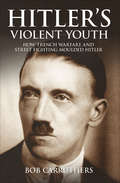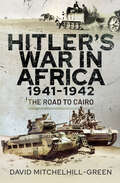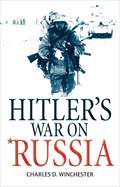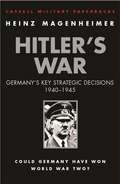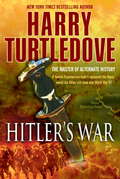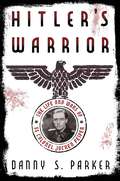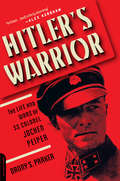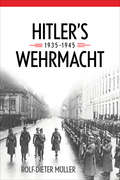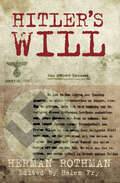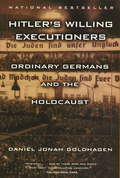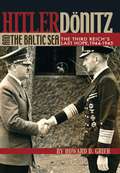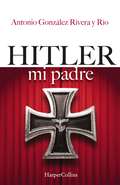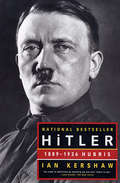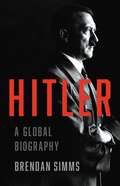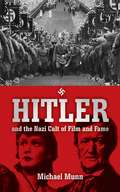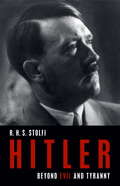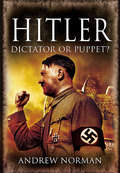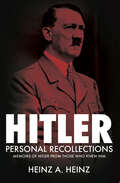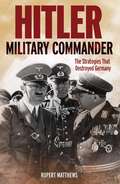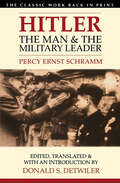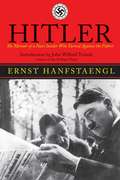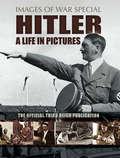- Table View
- List View
Hitler's Violent Youth: How Trench Warfare and Street Fighting Moulded Hitler
by Bob CarruthersAn Emmy Award–winning author and historian delves into the brutal early life of the man who would become Nazi Germany&’s maniacal dictator. Between 1889 and 1924, Adolph Hitler&’s political outlook was borne out of vicious incidents that heralded the formation of the Sturmabteilung—the notorious SA. Drawing extensively on Hitler&’s own biographical account in Mein Kampf, Bob Carruthers illustrates how these events influenced the future führer&’s worldview and led directly to the Beer Hall Putsch of 1923. Hitler&’s difficult relationship with his cruel father, his harsh experiences in Vienna, and his involvement in the Great War all conditioned him to celebrate violent acts. By Hitler&’s own account, his complete disregard for the consequences of his actions was vindicated by his victories in fierce encounters including beer hall brawls and street battles. Each successive triumph over adversity influenced his decision-making process, imbuing him with a love of violence and culminating in the ill-fated events of November 1924, which saw Hitler imprisoned for the second time. Carruthers also explores the parallel growth of the SA from a small group of fist fighters to a feared paramilitary force along with a comprehensive survey of the violent events between 1920 and 1924, which shaped this infamous political instrument of terror alongside the man who instigated World War II.
Hitler's War in Africa 1941–1942: The Road to Cairo
by David Mitchelhill-GreenAdolf Hitler’s war in Africa arose from the urgent need to reinforce the Italian dictator, Benito Mussolini, whose 1940 invasion of Egypt had been soundly beaten. Of secondary importance to his ideological dream of conquering the Soviet Union, Germany’s Führer rushed a small mechanised force into the unfamiliar North African theatre to stave off defeat and avert any political fallout. This fresh account begins with the arrival of the largely unprepared German formations, soon to be stricken by disease and heavily reliant upon captured materiel, as they fought a bloody series of see-sawing battles across the Western Desert. David Mitchelhill-Green has gathered a wealth of personal narratives from both sides as he follows the brash exploits of General Erwin Rommel, intent on retaking Libya; the Nile firmly in his sights. Against this backdrop is the brutal human experience of war itself.
Hitler's War on Russia
by Charles WinchesterThe Russian front was the decisive theater of World War II with the great mass of the German army and Luftwaffe locked in battle with the Red Army in the largest land campaign in history. On a 1,200-mile front from the Arctic Circle to the Caspian Sea, in baking summer heat and winter temperatures of -40¿C, millions of men and women fought the most vital battle of the war. Had the Germans won in the East, a Nazi victory in World War II would have been almost inevitable.This book examines the German campaign on the Eastern Front, from their first significant defeat at the gates of Moscow in 1941 to the defeat at Stalingrad and the Russian capture of Berlin marking the end of the war in Europe, exploring how Hitler's flawed dream of conquest in the East brought about the end of the Thousand Year Reich - in little over a thousand days.Introduction * Hitler and the Wehrmacht * The Red Army * To the Gates of Moscow * Attack and Counter-attack * Verdun on the Volga: Stalingrad * The Correlation of Forces * The Last Blitzkrieg * The Writing on the Wall * Prussian Roulette * Goodbye to Berlin * Notes * Index * Select BibliographyFrom the Trade Paperback edition.
Hitler's War: Germany's Key Strategic Decisions 1940-45
by Heinz MagenheimerThis is a closely argued and wide-ranging assessment of just how, with so many alternatives open, the German High Command chose the path that led, ultimately, to its own destruction. Heinz Magenheimer examines in detail the options that were open to the Germans as the war progressed. He identifies the crucial moments at which fateful decisions needed to be made, and considers how decisions different from those actually taken could have propelled the conflict in entirely different directions. Using the very latest source material, in particular new research from Soviet Russian sources, the author analyses motives and objectives and considers the opportunities acted upon or rejected, concentrating especially on specific phases of the conflict.
Hitler's War: Germany's Key Strategic Decisions 1940-45
by Heinz MagenheimerThis is a closely argued and wide-ranging assessment of just how, with so many alternatives open, the German High Command chose the path that led, ultimately, to its own destruction. Heinz Magenheimer examines in detail the options that were open to the Germans as the war progressed. He identifies the crucial moments at which fateful decisions needed to be made, and considers how decisions different from those actually taken could have propelled the conflict in entirely different directions. Using the very latest source material, in particular new research from Soviet Russian sources, the author analyses motives and objectives and considers the opportunities acted upon or rejected, concentrating especially on specific phases of the conflict.
Hitler's War: The War That Came Early, Book One (The War That Came Early #1)
by Harry TurtledoveA novel that reveals the human face of war while simultaneously riding the twists and turns that make up the great acts of history, "Hitler's War" is the beginning of an exciting new alternate history saga.
Hitler's Warrior
by Danny S. ParkerFrom a leading expert, a definitive biography of the fearsome and controversial German SS tank commander of "Hitler’s Own” Panzer Division
Hitler's Warrior
by Danny S. ParkerFrom a leading expert, a definitive biography of the fearsome and controversial German SS tank commander of "Hitler’s Own” Panzer Division
Hitler's Warrior: The Life and Wars of SS Colonel Jochen Peiper
by Danny S. ParkerFrom a leading expert, a definitive biography of the fearsome and controversial German SS tank commander of "Hitler's Own" Panzer Division
Hitler's Warrior: The Life and Wars of SS Colonel Jochen Peiper
by Danny S. ParkerFrom a leading expert, a definitive biography of the fearsome and controversial German SS tank commander of "Hitler’s Own” Panzer Division
Hitler's Wehrmacht, 1935–1945 (Foreign Military Studies)
by Rolf-Dieter MüllerAn &“impressively comprehensive&” study of the Nazi military and its culpability in war crimes by &“one of the foremost historians of World War II&” (Stephen G. Fritz, author of Ostkrieg). Since the end of World War II, Germans have struggled with the legacy of the Wehrmacht—the unified armed forces mobilized by Adolf Hitler in 1935. Historians have vigorously debated whether the Wehrmacht's atrocities represented a break with the past or a continuation of Germany's military traditions. Now available for the first time in English, this meticulously researched yet accessible overview by eminent historian Rolf-Dieter Müller provides a comprehensive analysis of the Wehrmacht, illuminating its role in the horrors of the Third Reich. Müller examines the Wehrmacht's leadership principles, organization, equipment, and training, as well as the front-line experiences of soldiers, airmen, Waffen SS, foreign legionnaires, and volunteers. He skillfully demonstrates how state-directed propaganda and terror influenced the extent to which the militarized citizenry—or Volksgemeinschaft—was transformed under the pressure of total mobilization. Finally, Müller evaluates the army's conduct during the war, from blitzkrieg to the final surrender and charges of war crimes. Brief acts of resistance, such as an officers' &“rebellion of conscience&” in July 1944, embody the repressed, principled humanity of Germany's soldiers. But ultimately, Müller concludes, the Wehrmacht became the &“steel guarantor&” of the criminal Nazi regime.
Hitler's Will
by Helen Fry Herman RothmanHerman Rothman arrived in Britain from Germany as a Jewish refugee in 1939, on the eve of the Second World War. He volunteered for HM Forces, serving in the Intelligence Corps, and in 1945 was posted to Westertimke and Fallingbostel prisoner of war camps to interrogate high-ranking Nazi war criminals. When papers were discovered sewn into the shoulders of a jacket belonging to Heinz Lorenz, who had been Joseph Goebbels' press secretary, he and a team of four others were charged with translating them under conditions of the deepest secrecy. The documents turned out to be the originals of Hitler's personal and political wills, and Goebbels' addendum. Later, in Rotenburg hospital, Rothman interrogated Hermann Karnau, who had been a police guard in Hitler's bunker, to establish informaiton about the Fuhrer's death. 'Hitler's Will' is the amazing true story of Herman Rothman's remarkable life, including how he managed to escape from Nazi Germany before the War began, and his role in bringing to light Hitler's personal and political testaments.
Hitler's Willing Executioners: Ordinary Germans and the Holocaust
by Daniel Jonah GoldhagenThis groundbreaking international bestseller lays to rest many myths about the Holocaust: that Germans were ignorant of the mass destruction of Jews, that the killers were all SS men, and that those who slaughtered Jews did so reluctantly. Hitler's Willing Executioners provides conclusive evidence that the extermination of European Jewry engaged the energies and enthusiasm of tens of thousands of ordinary Germans. Goldhagen reconstructs the climate of "eliminationist anti-Semitism" that made Hitler's pursuit of his genocidal goals possible and the radical persecution of the Jews during the 1930s popular. Drawing on a wealth of unused archival materials, principally the testimony of the killers themselves, Goldhagen takes us into the killing fields where Germans voluntarily hunted Jews like animals, tortured them wantonly, and then posed cheerfully for snapshots with their victims. From mobile killing units, to the camps, to the death marches, Goldhagen shows how ordinary Germans, nurtured in a society where Jews were seen as unalterable evil and dangerous, willingly followed their beliefs to their logical conclusion. "Hitler's Willing Executioner's is an original, indeed brilliant contribution to the. . . literature on the Holocaust."--New York Review of Books "The most important book ever published about the Holocaust. . . Eloquently written, meticulously documented, impassioned. . . A model of moral and scholarly integrity."--Philadelphia Inquirer
Hitler, Donitz, and the Baltic Sea
by David GrierThe popular conception of Hitler in the final years of World War II is that of a deranged Fuhrer stubbornly demanding the defense of every foot of ground on all fronts and ordering hopeless attacks with nonexistent divisions. To imply that Hitler had a rational plan to win the war flies in the face of widely accepted interpretations, but historian Howard D. Grier persuasively argues here that Hitler did possess a strategy to regain the initiative in 1944-45 and that the Baltic theater played the key role in his plan.In examining that strategy, Grier answers lingering questions about the Third Reich's final months and also provides evidence of its emphasis upon naval affairs and of Admiral Karl Donitz's influence in shaping Hitler's grand strategy. Donitz intended to starve Britain into submission and halt the shipment of American troops and supplies to Europe with a fleet of new Type XXI U-boats. But to test the new submarines and train their crews the Nazis needed control of the Baltic Sea and possession of its ports, and to launch their U-boat offensive they needed Norway, the only suitable location that remained after the loss of France in the summer of 1944.This work analyzes German naval strategy from 1944 to 1945 and its role in shaping the war on land in the Baltic. The first six chapters provide an operational history of warfare on the northern sector of the eastern front and give evidence of the navy s demands that the Baltic coast be protected in order to preserve U-boat training areas. The next three chapters look at possible reasons for Hitler's defense of the Baltic coast, concluding that the most likely reason was Hitler's belief in Donitz's ability to turn the tide of war with his new submarines. A final chapter discusses Donitz's personal and ideological relationship with Hitler, his influence in shaping overall strategy, and the reason Hitler selected the admiral as his successor rather than a general or Nazi Party official. With Grier's thorough examination of Hitler's strategic motives and the reasons behind his decision to defend coastal sectors in the Baltic late in the war, readers are offered an important new interpretation of events for their consideration.
Hitler, mi padre
by Antonio González Rivera y RíoCuando el Ejército Rojo está a punto de conquistar Berlín, a finales de la Segunda Guerra Mundial, en el cuartel general de Hitler se Fragua el más arriesgado de los planes: la huida de Hitler y su esposa Eva Braun; pero más aún, de su mayor secreto: le existencia de sus dos hijos. En esta estremecedora novela, un hombre se atreve e contar su historia: la de cómo descubrió que es el hijo del hombre más temido y más odiado del siglo XX.
Hitler: 1889-1936 Hubris
by Ian KershawHailed as the most compelling biography of the German dictator yet written, Ian Kershaw's Hitler brings us closer than ever before to the heart of its subject's immense darkness. From his illegitimate birth in a small Austrian village to his fiery death in a bunker under the Reich chancellery in Berlin, Adolf Hitler left a murky trail, strewn with contradictory tales and overgrown with self-created myths. One truth prevails: the sheer scale of the evils that he unleashed on the world has made him a demonic figure without equal in this century. Ian Kershaw's Hitler brings us closer than ever before to the character of the bizarre misfit in his thirty-year ascent from a Viennese shelter for the indigent to uncontested rule over the German nation that had tried and rejected democracy in the crippling aftermath of World War I. With extraordinary vividness, Kershaw recreates the settings that made Hitler's rise possible: the virulent anti-Semitism of prewar Vienna, the crucible of a war with immense casualties, the toxic nationalism that gripped Bavaria in the 1920s, the undermining of the Weimar Republic by extremists of the Right and the Left, the hysteria that accompanied Hitler's seizure of power in 1933 and then mounted in brutal attacks by his storm troopers on Jews and others condemned as enemies of the Aryan race. In an account drawing on many previously untapped sources, Hitler metamorphoses from an obscure fantasist, a "drummer" sounding an insistent beat of hatred in Munich beer halls, to the instigator of an infamous failed putsch and, ultimately, to the leadership of a ragtag alliance of right-wing parties fused into a movement that enthralled the German people. This volume, the first of two, ends with the promulgation of the infamous Nuremberg laws that pushed German Jews to the outer fringes of society, and with the march of the German army into the Rhineland, Hitler's initial move toward the abyss of war.
Hitler: A Global Biography
by Brendan SimmsFrom a prize-winning historian, the definitive biography of Adolph HitlerHitler offers a deeply learned and radically revisionist biography, arguing that the dictator's main strategic enemy, from the start of his political career in the 1920s, was not communism or the Soviet Union, but capitalism and the United States. Whereas most historians have argued that Hitler underestimated the American threat, Simms shows that Hitler embarked on a preemptive war with the United States precisely because he considered it such a potent adversary. The war against the Jews was driven both by his anxiety about combatting the supposed forces of international plutocracy and by a broader desire to maintain the domestic cohesion he thought necessary for survival on the international scene.A powerfully argued and utterly definitive account of a murderous tyrant we thought we understood, Hitler is essential reading for anyone seeking to understand the origins and outcomes of the Second World War.
Hitler: And the Nazi Cult of Film and Fame
by Michael MunnA shocking look into the twisted, lurid world of Nazi Germany’s film industry. In Nazi Germany, the cult of celebrity was the embodiment of Adolf Hitler’s style of cultural governance. Hitler’s rise to power owed much to the creation of his own celebrity, and the country’s greatest stars, whether they were actors, writers, or musicians, could be one of only two things: If they were compliant, they were lauded and awarded status symbols for the regime; but if they resisted—or were simply Jewish—they were traitors to be interned and murdered. This fascinating analysis offers a shocking portrait of a Hitler shaped by aspirations to Hollywood-style fame, of the correlation between art and ambition, of films used as weapons, and of sexual predilections. The Führer believed he was an artist, not a politician, and in his Germany, politics and culture became one. His celebrity was cultivated and nurtured by Joseph Goebbels, Germany’s supreme head of culture. Hitler and Goebbels enjoyed the company of beautiful female film stars, and Goebbels had his own “casting couch.” In Germany’s version of Hollywood, there were scandals, starlets, secret agents, premieres, and party politics. The Third Reich would launch filmmaker and actress Leni Riefenstahl to prominence by making her its own glorifying documentarian, most famously in The Triumph of the Will, the innovative film starring Hitler and widely considered to be one of the greatest propaganda movies ever made. It is no coincidence that Eva Braun, Hitler’s longtime partner and wife for the two days leading up to their joint suicide, was a photographer, and in fact shot most of the surviving photographs and film footage of her lover. In this “creepy yet compelling who’s-who of collaboration in the big-screen industry during the Nazi era,” film historian Michael Munn “offers a hard-driving study of Hitler’s music and film obsessions and the sacrifice of untold talent and youth to the murderous Nazi ideology” (Kirkus Reviews). Hitler and the Nazi Cult of Film and Fame also reveals previously unpublished information about the “Hitler film,” which Goebbels envisaged as “the greatest story ever told,” although it was ultimately trumped by the dictator’s own, real-life Wagnerian finale.
Hitler: Beyond Evil and Tyranny (German Studies)
by R. H. StolfiCountless books, including five major biographies, have been devoted to the subject of Adolf Hitler. Yet, despite the mass of tantalizing detail uncovered over six decades, the man at the center of so much historical, psychological, and political analysis remains elusive. For some, he was evil personified, a diabolical tyrant driven by a lust for power; for others, he was a banal demagogue, an opportunist with a talent for propaganda and oration but little more than an empty vessel embodying the disappointments of a defeated Germany. Though we know many facts about Hitler, no coherent picture of his character or personality emerges. Instead, we are left with a cardboard cutout of an evil dictator whose life, in the end, no one can really explain. This fascinating and richly detailed new biography of Hitler reinterprets the known facts about the Nazi Fuehrer to construct a convincing, realistic portrait of the man. In place of the hollow shell others have made into an icon of evil, the author sees a complex, nuanced personality. Without in any way glorifying its subject, this unique revision of the historical Hitler brings us closer to understanding a pivotal personality of the twentieth century.
Hitler: Dictator or Puppet?
by Andrew NormanWritten by an authority on Adolf Hitler, this book charts new ground and shows how the writings of a deluded ex-monk, Lanz von Liebenfels and the pseudo-science of Liebenfels and other writers, convinced Hitler that Germanys destiny was to save the world from a Jewish-Bolshevik conspiracy. It was this perverted sense of destiny that drove the Nazi Party and led to the outbreak of WWII and the deaths of some sixty million people as well as the destruction of much of Europe. Using the writings of Liebenfels from his magazine Ostara, Dr Andrew Norman demonstrates how the mass murders of Jews, Gypsies, mentally-ill people and those regarded as less than human had its roots in articles written by Liebenfels. An index of Ostara articles is included and their very titles indicate the malign influences that shaped Hitlers Germany.
Hitler: Memoirs of Hitler From Those Who Knew Him
by Heinz A. HeinzHeinz A. Heinz was the only writer authorised by the Nazi Party to draw a biography of the Fhrer for publication in the English speaking world. The result was the 1938 authorised biography of Adolf Hitler entitled Germany's Hitler.The book was based on interviews supplied first hand by those friends, helpers and comrades who had believed in him from the beginning of his political career. Heinz A. Heinz was a professional journalist and author, he interviewed Hitler's old school friends, army colleagues, landlords, his jailer, and early party comrades including an invaluable interview with Anton Drexler to produce an unprecedented insight into Adolf Hitler as viewed by his acquaintances during the inter-war period.These remarkable interviews were given by those who had stood by him in his darkest days, and who lived to see one of the most astounding political achievements in history. Included are vivid and unique descriptions of Hitler at school, his First World War battlefield experiences, the early political struggles, the full story behind the 9th November Beer Hall Putsch, Hitler in prison, and the struggle to power from 1926 to 1933.Featuring a new introduction by Emmy Award winning writer and historian Bob Carruthers, this book is a vital primary source reference work for anyone interested in understanding how and why Hitler won the total adulation and support of such a large section of the German people.
Hitler: Military Commander
by Rupert MatthewsA comprehensive examination of Hitler’s military strategies.As Führer of the Third Reich, Hitler was responsible for deciding the German war aims in 1939. As head of the Armed Forces from February 4th, 1938, he was also responsible for the overall Wehrmacht strategy intended to achieve these aims. Hitler: Military Commander examines with impeccable detail Hitler's key military decisions during the Second World War, and assesses how far these decisions were militarily justified in the light of the intelligence available at the time. Perhaps most importantly, it tackles the larger questions of how a non-German former corporal, albeit the holder of the Iron Cross First Class, managed to take personal control of an army with the Prussian traditions of the German army; to appoint, sack, and sentence to death its generals at will, to lead it into a World War it was not prepared for; and to ultimately destroy it. Featuring black-and-white photographs, maps, biographical context, tactical analysis, and more, this new edition of Hitler: Military Commander will give readers the comprehensive overview of Hitler's military decisions and downfall.
Hitler: The Man and the Military Leader
by Donald S. Detwiler Percy Ernst SchrammPercy Ernst Schramm, one of Germany's most distinguished historians, had exceptional access to Adolf Hitler because from January 1943 to the end of the war he was the Fuhrer's official war diarist. This classic volume, long out of print, contains the introductions written by Schramm to critical editions of Hitler's Table Talk and the official War Diary of the High Command of the Wehrmacht. In addition, there are two appendices: the first consisting of excerpts from a study composed by Schramm for the Nuremberg Trials on relations between Hitler and the General Staff; the second a memorandum written by General Jodl in 1946 on Hitler's military leadership.
Hitler: The Memoir of the Nazi Insider Who Turned Against the Fuhrer
by Ernst Hanfstaengl John Willard TolandOf American and German parentage, Ernst Hanfstaengl graduated from Harvard and ran the family business in New York for a dozen years before returning to Germany in 1921. By chance he heard a then little-known Adolf Hitler speaking in a Munich beer hall and, mesmerized by his extraordinary oratorical power, was convinced the man would some day come to power. As Hitler's fanatical theories and ideas hardened, however, he surrounded himself with rabid extremists such as Goering, Hess, and Goebbels, and Hanfstaengl became estranged from him. But with the Nazi's major unexpected political triumph in 1930, Hitler became a national figure, and he invited Hanfstaengl to be his foreign press secretary. It is from this unique insider's position that the author provides a vivid, intimate view of Hitler--with his neuroses, repressions, and growing megalomania--over the next several years. In 1937, four years after Hitler came to power, relations between Hanfstaengl and the Nazis had deteriorated to such a degree that he was forced to flee for his life, escaping to Switzerland. Here is a portrait of Hitler as you've rarely seen him.
Hitler: The Official Third Reich Publication (Images of War Special)
by Bob CarruthersThis exceptional source is probably the best of the contemporary accounts of Hitler in power, albeit from a heavily pro-Nazi stance. The testimonies collected together were based on interviews conducted by Heinz A. Heinz in 1933 and 1934, shortly after Hitler had taken power.Millions of ordinary Germans fell under Hitler's spell and this book is a creation of those emotions. It is very much a product of its time. Written by the party big-wigs, such as Goering, Speer and Goebbels, and published in 1935 under the title Adolf Hitler Bilder Aus Dem Leben Des Furhers, it appeared at a time when they were at the height of their unrivaled powers. This fascinating volume encompasses the superb photography of Heinrich Hoffman, the Munich photographer who was ever present on Hitler's journeys and who grew fabulously wealthy as a result of his intimate access to Hitler. Hitler had an innate understanding of what we would now call public relations. He recognised the excellence of Hoffman's photography and maintained control of his image by limiting the access of other photographers. He also strictly controlled Hoffmann's activities and personally selected the portraits that were allowed to go into circulation.The book incorporates sections on Hitler and the German people, Hitler and the German workers, Hitler and public works and so on, all accompanied by a series of excellent photographs which form a remarkable record of the public face of a man during his brief spell of absolute power. The Nazis were the first party who harnessed the full power of the media in a coherent and all-embracing manner.This is a classic example of the strength of their presentation skills. It is a compelling time-capsule which conveys vividly in almost visceral way the zeitgeist of the thirties in Nazi-Germany. By 1935 the bulk of the German people had fallen in behind Adolf Hitler, and with documents as persuasive as this, it is not too difficult to comprehend the allure of the glittering faade which a stream of publications such as this book sought to create and maintain.
